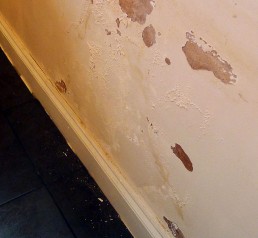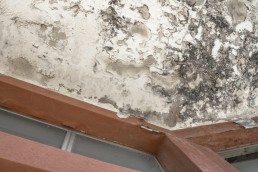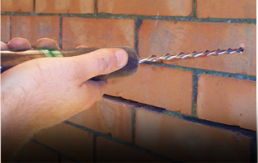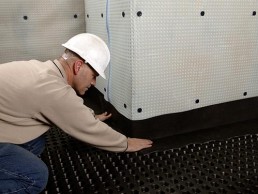Rising Damp on Internal Walls
Rising damp is a serious problem that can cause costly damage to a property if left untreated. Luckily, it’s not a problem that homeowners have to deal with often, but it’s still important to ensure that your home is protected against the most common causes of rising damp.
Rising damp can affect both internal and external walls, with internal walls being particularly prone to damage. In this article, the experts at Danford, Brewer & Ives explain how to stop rising damp on internal walls.
What Is Rising Damp?
Rising damp is a flow of vertical water that rapidly spreads from ground level, upwards. It’s one of the three common forms of damp that can affect a property (the other two being penetrating damp and condensation).
Water can work its way through brick walls and masonry, before spreading through a property’s internal walls. Learning how to stop rising damp on internal walls is important, as it can rapidly move through a home using capillary action.
If you notice any of the following signs on your internal walls, you could have a rising damp problem:
- Tide marks on internal walls
- Damp patches on internal walls
- Peeling wallpaper or paint
- Rotting skirting boards, door frames or window frames
- Mould or other fungal growths
- Musty smells
- Corroded bricks
- Discoloured external walls
If you are worried about rising damp on internal walls, it’s a good idea to have a damp specialist carry out a survey. They’ll be able to identify the type of damp and its cause, before recommending a solution.
How to Stop Rising Damp on Internal Walls
There are several ways to stop rising damp, and the exact treatment recommended by a specialist will depend on a number of factors. These include the extent of the rising damp problem, the amount of damage already caused, and where exactly in the home the rising damp problem is.
Treatments for rising damp focus on removing the current source of the damp, such as damp floorboards or rotten timbers, and adding protection to stop rising damp occurring again.
The four most effective ways to stop rising damp on internal walls include:
- Removing the source of the damp, including any damaged plasterwork or skirting boards.
- Removing and replacing rotten floorboards or damp sections of walls affected by the rising damp.
- Injecting a chemical damp proof course into the walls, thereby creating a waterproof barrier to stop rising damp from occurring in the future.
- Removing soil from around the base of an external wall to bring it below any existing damp proof course.
Contact Danford, Brewer & Ives to Find Out More About Stopping Rising Damp
For more information and advice on rising damp on internal walls, please contact our friendly team on 01765 804050 or fill in our online contact form.
Our experienced specialists will be on hand and ready to offer expert advice tailored to resolve your problem.
Rising Damp on External Walls
Rising damp is a serious problem that homeowners need to stop dead in its tracks. Caused by water seeping into brickwork and masonry, rising damp can lead to dangerous structural damage and hazardous health issues such as mould.
Rising damp can affect both external and internal walls, but it’s often more difficult to spot rising damp that’s taken hold on the outside of a building. Learning how to stop rising damp on external walls is important for the safety of your house, so in this article the experts at Danford, Brewer & Ives explain how.
What Is Rising Damp on External Walls?
Rising damp is best defined as an upward movement of water, spreading rapidly from the ground as it moves through walls using capillary action. Rising damp is caused by water seeping into masonry, most commonly from the outside, so it often takes hold on external walls before spreading inside the home.
Rising damp can quickly spread inside from the outside, so learning how to stop rising damp on external walls can help you to contain a damp problem before it causes too much damage. If left untreated, external rising damp can rapidly move inside, causing damage to walls, floors and even ceilings. This can mean costly repairs, structural damage and potentially hazardous mould problems that can prove dangerous to the health of the occupants.
There are several signs you can look for that may indicate you have a rising damp problem on your external walls, including:
- Tide marks on external walls
- Discolouration on external walls
- External walls are damp to touch
- Crumbling masonry or broken brickwork
- Growths of moss on the outside of the home
- Musty, mouldy smells around the home
It’s also possible that you’ll notice damage to the inside of a home, as the rising damp spreads from the outside. You might notice peeling plaster, discolouration, tide marks, damp or mould on internal walls.
How to Stop Rising Damp on Internal Walls
If you notice any signs of rising damp, contact a professional immediately for a damp survey, as they’ll be able to recommend how to stop rising damp on external walls before too much damage has been caused.
The four most effective ways to stop rising damp on external walls are:
- Isolating the source of the damp, be it a broken drainpipe, flooding, etc.
- Removing and replacing damp masonry or bricks affected by rising damp.
- Injecting a chemical damp proof course into the external walls, thereby creating a waterproof barrier to stop rising damp from occurring in the future.
- Removing soil from around the base of an external wall to bring it below any existing damp proof course.
Contact Danford, Brewer & Ives to Find Out More About Rising Damp
For more information and advice on rising damp on external walls, please contact our friendly team on 01765 804050 or fill in our online contact form.
Our experienced specialists will be on hand and ready to offer expert advice tailored to resolve your problem.
Can a Water Leak Cause Rising Damp?
Can a water leak cause rising damp? That’s an important question that our experts at Danford, Brewer & Ives are frequently asked.
The short answer is yes, a water leak can cause rising damp, leading to the growth of mould, rotten floorboards and potentially dangerous structural problems in your home.
Rising damp is a serious problem. In this article, we explain in more detail how water leaks can be troublesome, and when you need to call in the professionals.
What Can Cause Rising Damp?
Rising damp is a vertical movement of water from the ground, upwards. If left untreated, it can quickly spread through a home using capillary action.
Rising damp is a serious problem for homeowners, as it can be difficult to spot before it’s already started to cause damage. It’s most commonly caused by water seeping into the walls, bricks, timbers or masonry of a building, often from the outside.
Once water begins to seep through, it causes damp and mould and can decay timbers, cause crumbling masonry, and rapidly leave behind damage as it makes its way further inside your property.
The cause of rising damp is water, but there can be many different reasons as to why water is seeping into your home. The most common causes are:
- Broken pipes
- Overflowing drains
- Flooding
- Excess groundwater
- Leaks
- A broken damp proof course
Can a Water Leak Cause Rising Damp?
So can a water leak cause rising damp? While there could be many causes for a rising damp problem, it’s common for the main culprit to be a leak.
Leaking pipes or broken drains leaking water into the ground can cause groundwater levels to rise, resulting in rising damp. This can occur even if you have a damp proof course installed, as rising water levels may flow above the level of the waterproof damp proof course.
Leaks may also occur in bathrooms, kitchens, pantries or any other areas where there are taps or pipes. Large leaks caused by burst pipes or broken toilets will be noticed easily, but even small leaks can lead to rising damp. Over time, leaky bathtubs or sinks can result in damp patches forming on the floor, or broken seals on showers can lead to a build up of moisture that can seep into the walls.
If you’re concerned about rising damp, it’s important to call in a specialist quickly. Identifying the cause of a rising damp problem can be difficult, but if there is a leak, this needs to be fixed before it leads to more costly damages.
Contact Danford, Brewer & Ives to Find Out More About Rising Damp
For more information and advice on identifying the causes of a rising damp problem, please contact our friendly team on 01765 804050 or fill in our online contact form.
Our experienced rising damp specialists will be on hand and ready to offer expert advice tailored to resolve your problem.
How to Treat Rising Damp in an Old House
Rising damp can pose a serious problem to homeowners and, if left untreated, can lead to mould, structural damage and health hazards.
In an older house, rising damp is not only more likely to occur, but it can be more difficult to treat than in newer, more modern homes.
If you’re wondering how to treat rising damp in an old house, the experts at Danford, Brewer & Ives are here to explain everything you need to know.
Why Does Rising Damp Affect Older Houses?
Rising damp is best defined as an upward movement of water through the walls of a building. Water moves from ground level upwards using capillary action to rapidly spread through the bricks and masonry of a home.
There can be many reasons as to why buildings are affected by rising damp. Common causes including flooding, excess groundwater, leaks, or broken infrastructure such as drains and pipes.
While these problems can affect all houses, older houses are particularly susceptible because they might not have a protective damp proof course installed. Older houses dating back to the 19th century were not built with a damp proof course, or DPC, which modern houses have as standard. Without a waterproof damp proof course, it’s much easier for water to seep into walls from the outside.
How to Treat Rising Damp in an Old House
Rising damp needs to be treated quickly in order to limit the potential damage it might cause to a property.
In older houses, rising damp commonly occurs because a damp proof course has never been installed. If a damp proof course is installed, then it’s also possible that an old DPC may have failed. If this is the case, the best way to treat rising damp in an old house is to have a new damp proof course installed.
Depending on the extent of the rising damp problem, rotten timbers or damaged sections of wall or masonry affected by the damp may need to be removed and replaced, before a chemical damp proof course is injected into the walls.
Another issue that may need fixing is rising groundwater. Over time, the DPC may slip below the waterline, therefore becoming redundant. If this has occurred, then the soil can be dug out around a home to make the DPC more effective.
A damp specialist can quickly check if there is a damp proof course, or if there is another cause of rising damp. Because of the potential complications and dangers involved when working on older houses, particularly those dating back to the Victorian era or beyond, it’s always recommended to call in a professional specialist if you believe your home might have rising damp.
Contact Danford, Brewer & Ives to Find Out More About Treating Rising Damp
For more information and advice on how to treat rising damp in an old house, please contact our friendly team on 01765 804050 or fill in our online contact form.
Our experienced specialists will be on hand and ready to offer expert advice tailored to resolve your problem.
Will External Wall Insulation Stop Mould?
Mould is a homeowner’s nightmare. This smelly, fungal spore thrives in wet and damp conditions, and is costly to remove as well as having potentially serious effects on the health of the home’s occupants.
There are many ways to damp and mould proof your home, but one of the most effective methods is to install external wall insulation. This is a big structural improvement to a property, so in this article, the experts at Danford, Brewer & Ives examine the effectiveness of external wall insulation in stopping mould.
Here’s our answer to the question, ‘Will external wall insulation stop mould?’
What Is External Wall Insulation?
You might be wondering how external wall insulation could stop mould. After all, aren’t insulating materials designed to insulate, rather than protect against problems like damp and mould?
You’re not wrong. External wall insulation is most commonly installed against solid stone walls. It adds an extra layer to the outside of a home, leaving a cavity space that can be filled with insulating materials. This stops heat from escaping, thereby saving you money on your energy bills while also helping the environment.
External wall insulation has the added advantage of being waterproof. Because it’s installed on the outside of a building, the materials used need to be able to withstand British weather, so they are commonly constructed from resistant, impermeable materials that create a waterproof barrier.
It’s this waterproof feature that ensures external wall insulation can help you to fight mould.
Will External Wall Insulation Stop Mould?
Mould needs moisture to survive. In damp, wet conditions, it’s quite easy for a mould problem to get out of control as it spreads throughout a home.
Mould is commonly caused by water seeping into walls from the outside. With the addition of an external, waterproof layer on the outside of the home, you’re protecting your household against one of the primary causes of mould. If water can’t get inside the walls or into the masonry and timbers, then mould will find it difficult to survive without the moisture it needs.
So, will external wall insulation stop mould? Yes. Although it can be a costly addition to a home, external wall insulation is waterproof and highly effective at combating damp, mould, leaks and seeping water that would otherwise cause damage to your property and could prove hazardous to human health.
The upfront installation costs are generally recouped as you save on repairs and maintenance, too. And don’t forget, the primary goal of external wall insulation is to stop heat from escaping, so you’ll also save significant amounts of energy and money over time.
Contact Danford, Brewer & Ives to Find Out More About External Wall Insulation
For more information and advice on installing external wall insulation, then please contact our friendly team on 01765 804050 or fill in our online contact form.
Our experienced specialists will be on hand and ready to offer expert advice tailored to resolve your problem.
Is a Damp Proof Membrane Necessary?
Damp proof membranes form an effective barrier against moisture. When properly installed, they offer protection against damp, mould and many other serious problems that can affect your property.
Many homeowners wonder if having a damp proof membrane installed is worth the cost, so in this article we explain why a damp proof membrane is so important.
Find out more as the experts at Danford, Brewer & Ives answer the question, ‘Is a damp proof membrane necessary?’
What Is a Damp Proof Membrane?
A damp proof membrane is a thick sheet of waterproof materials, usually plastic composites, which is installed as a barrier to stop water from seeping into a property.
A damp proof membrane, or DPM, is required to be a minimum of 1200 gauge in thickness and is commonly installed above or below floorboards, and on the inside or outside of a property’s walls.
Is a Damp Proof Membrane Necessary?
So, is a damp proof membrane necessary? The short answer is yes, because a damp proof membrane can help protect your home against a variety of potentially serious issues.
As a waterproof barrier, damp proof membranes protect against moisture and water leaking into the walls, floorboards, timbers and masonry. This stops damp from forming, mould from spreading, and fungal spores from taking hold throughout the house.
Without a damp proof membrane, moisture can quickly spread through a property. If left unchecked, issues like damp and mould can cause serious structural problems, they can be costly to repair, and they can prove hazardous to human health.
An effective damp proof membrane, while also protecting against damp and mould, has the added bonus of being a useful insulator. It creates an impermeable barrier, trapping heat and lowering a property’s energy output. This not only helps you to save money on your gas or electric bills, but it’s an excellent way to save resources while helping the environment.
How Effective Is a Damp Proof Membrane?
A damp proof membrane has the potential to create a very effective barrier against moisture and water, but only if properly installed across your property.
Damp proof membranes can be cut to size and installed in such a way that they overlap, meaning there’s no way water can get through and into your home. Damp proof membranes are most effective when they are used in conjunction with a damp proof course and other damp proofing methods.
It’s always recommended to have a damp proof membrane installed professionally. A damp proofing specialist can identify the most strategic locations in your household for installation, ensuring that the damp proof membrane can function as both a waterproof and an insulating barrier.
Contact Danford, Brewer & Ives to Find Out More About Damp Proof Membranes
For more information and advice on installing damp proof membranes, please contact our friendly team on 01765 804050 or fill in our online contact form.
Our experienced specialists will be on hand and ready to offer expert advice tailored to resolve your problem.
Is It Worth Getting External Wall Insulation?
Is it worth getting external wall insulation? That’s a question we often hear at Danford, Brewer & Ives.
We understand why people are concerned, and that’s because external wall insulation can be a major change to the outside structure of your home. Plus it doesn’t come cheap.
However, external wall insulation not only saves you money on your energy bills, but it can help your home become greener and more environmentally friendly. If you’re wondering, ‘Is it worth getting external wall insulation?’ read our guide to its main advantages.
What Is External Wall Insulation?
External wall insulation is designed to add an extra, insulating layer to a home. It’s most commonly installed on top of solid stone walls, which often cause a property to lose large quantities of heat.
External wall insulation creates a cavity space, within which insulating materials can be added. This stops heat from escaping, which in theory lowers your energy bills and saves you money.
Is It Worth Getting External Wall Insulation?
But is it worth getting external wall insulation, considering it’s a costly improvement to a property? Here are the major benefits of having external wall insulation installed:
- Keep your home warm in winter
- Save money on energy bills
- Help the environment
- Protect against damp and mould
- Change the outside look of your home
As you can see, there are several advantages to be gained from installing external wall insulation. You save energy but your home stays warmer in winter, while you’re also playing your part in helping the environment by lowering your carbon footprint.
As well as being a great insulator, external wall insulation also has the added advantage of protecting against damp and mould. External wall insulation is waterproof, and it creates an impermeable barrier that stops water from seeping into your home. As a further bonus, external wall insulation can be stylish. It could be the smart new addition you need to tidy up the exterior of your property.
For many customers, the most important factor is cost. Financially, is it worth getting external wall insulation?
There’s no doubt that external wall insulation is a major addition to your property, and that comes with associated costs – particularly if you want the work carried out professionally and with the best materials. However, external wall insulation is guaranteed to save you money on your energy bills. Over several years, you’ll make back the upfront costs and then start saving, while the value of your property is certainly going to improve, too.
Contact Danford, Brewer & Ives to Find Out More About Installing External Wall Insulation
For more information and advice on installing external wall insulation, then please contact our friendly team on 01765 804050 or fill in our online contact form.
Our experienced specialists will be on hand and ready to offer expert advice tailored to resolve your problem.
What Does a Damp Proof Membrane Do?
Homeowners looking to protect their property should always ensure that there’s a damp proof membrane installed.
A damp proof membrane is a cost-effective way to avoid serious problems, such as damp, mould, rot, and more, while also helping to save energy by keeping houses insulated.
If you’re wondering whether your home needs a damp proof membrane, read on as the experts at Danford, Brewer & Ives answer the important question, ‘What does a damp proof membrane do?’
What Is a Damp Proof Membrane?
A damp proof membrane is an effective form of waterproofing that creates a protective barrier against damp and moisture. A damp proof membrane commonly consists of a durable sheet of plastic material produced to a government-regulated thickness that’s a minimum of 1200 gauge.
A damp proof membrane should always be installed by a damp proofing specialist, as it should be installed in key locations throughout a property. A damp proof membrane can be installed either above or below the floor or against the interior or exterior of a property’s walls.
What Does a Damp Proof Membrane Do?
So what does a damp proof membrane do? The main purpose of a waterproof damp proof membrane is to stop moisture from seeping into the walls, floors, timbers or masonry of a building.
By creating a waterproof barrier in strategic locations, a damp proof membrane protects a home against the potential dangers created by damp and moisture.
Damp can swiftly move through a building if there’s no protection against it, using capillary action to move from one wall to the next. If left untreated, damp can cause serious structural damage, wood rot, mould and fungal infections. Many of these issues can be costly to repair, while damp and mould can be hazardous to human health, too.
Importantly, damp proof membranes also act as useful insulators. When installed against walls or below floorboards, damp proof membranes act as insulating barriers, trapping heat and saving energy.
The energy-saving capacity of a damp proof membrane ensures that it’s a cost-effective addition to a home. Over time, the cost of the installation is generally recouped and exceeded by the potential energy savings that can be made over the course of several years.
How Effective Is a Damp Proof Membrane?
A damp proof membrane forms a protective barrier against problems like damp, mould and condensation.
However, for a damp proof membrane to be at its most effective, it should always be installed by a professional. A damp proof membrane can be installed in such a way that individual sheets overlap with one another; this ensures there are no gaps, and that your home is protected by an impermeable barrier.
Contact Danford, Brewer & Ives, to find out more about damp proof membranes.
For more information and advice on installing damp proof membranes, then please contact our friendly team on 01765 804050 or fill in our online contact form.
Our experienced specialists will be on hand and ready to offer expert advice tailored to resolve your problem.








